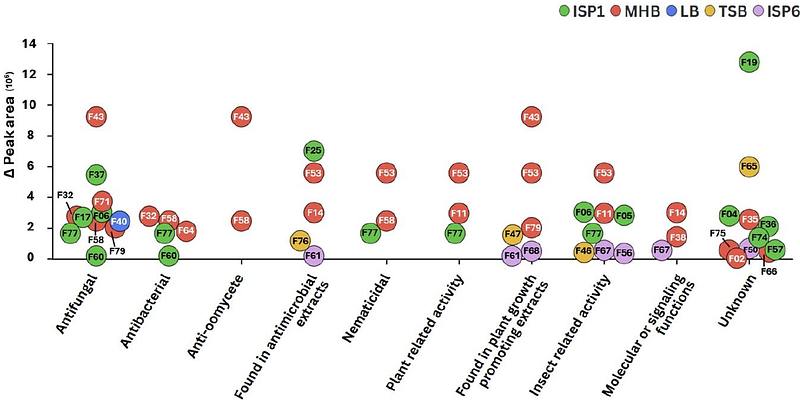The antifungal and other bioactive properties of the volatilome of Streptomyces scabiei

The antifungal and other bioactive properties of the volatilome of Streptomyces scabiei
Stulanovic, N.; Bensaada, D.; Belde, L.; Adam, D.; Hanikenne, M.; Focant, J.-F.; Stefanuto, P.-H.; Rigali, S.
AbstractVolatile compounds (VCs) produced by most host-associated bacteria remain largely unexplored despite their potential roles in suppressing microbial competitors and facilitating host colonization. This study investigated the volatilome of Streptomyces scabiei 87-22, the model species for causative agents of common scab in root and tuber crops, under culture conditions that completely inhibited fungal growth, including the phytopathogens Alternaria solani and Gibberella zeae. Bicameral assays confirmed that these inhibitory effects were at least partially mediated by VCs. Using GC x GC TOFMS, 36 VCs were unambiguously identified as products of S. scabiei 87-22 metabolic activity. These included mainly ketones and aromatic compounds (both benzene derivatives and heterocycles), along with smaller contributions from other chemical families including sulfur-containing compounds, nitriles, esters, terpenoids, an amide, and an aldehyde. A literature survey suggests that many of these VCs possess antibacterial, antifungal, anti-oomycete, nematocidal, and insecticidal effects, while the bioactivity of others remains speculative, having been identified only within complex volatile mixtures. Among those with known antifungal properties, dimethyl trisulfide, 2-heptanone, and creosol inhibited the growth of the fungal pathogens tested in this study. In addition, we reveal here that 3-penten-2-one is also a strong inhibitor of fungal growth. Remarkably, despite S. scabiei 87-22 being defined as a pathogen, some of its VCs were associated with plant growth promotion and defense stimulation. Overall, our work highlights the remarkable potential of S. scabiei 87-22 to produce VCs with diverse bioactivities including fungal pathogen inhibition and priming plant resistance.\n\nImportanceThis study reveals that Streptomyces scabiei, the bacterium causing common scab in root and tuber crops, produces a wide variety of volatile chemicals with surprising benefits. These natural compounds can inhibit growth of other harmful microbes, including fungal plant pathogens. Some of these chemicals are already known to fight pests and diseases, while others, like 3-penten-2-one, are newly discovered as potential antifungals. Even more unexpectedly, some of the identified compounds may help plants grow or boost their defenses. Combined with previous work, our findings challenge the idea that S. scabiei is purely harmful and suggests it might, under certain conditions, play a protective role in its environment. This work deepens our understanding of how microbes interact with each other and with plants, and could help shape more sustainable approaches to agriculture.